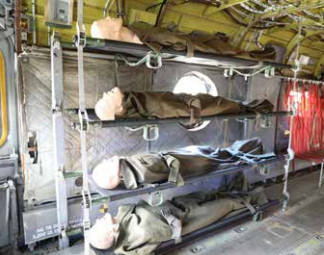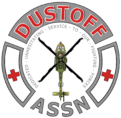By COL Samuel L. Fricks
Credit to Army Aviation Magazine – original publication March 31, 2023


Army Aviation will play a key role in casualty evacuation (CASEVAC) during large-scale combat operations (LSCO). The scope and scale of casualties of future conflict may be of a magnitude not seen since the first and second world wars. LSCO against a near-peer adversary will challenge U.S. and Allied capabilities to clear the battlefield of wounded and relieve congestion at roles of care. Medical assets, including medical evacuation (MEDEVAC), will quickly become saturated during the heights of conflict, jeopardizing the ability to evacuate patients through the Army Health System (AHS). As casualty numbers rapidly build, evacuation by any and all available means becomes critically essential to avoid encumbering ground commanders, restricting their ability to maneuver and creating a risk of mission failure. Army Aviation will be essential in evacuating casualties, either by preplanned dedicated assets or on platforms of opportunity. Deliberate CASEVAC considerations, with proficient and well-trained crews, must be synchronized into Aviation mission and medical planning.


Gaps Created by Years of Counterinsurgency Operations
Modern MEDEVAC has evolved into a rapidly responsive and extremely effective asset able to meet the demands of more than 20 years of counterinsurgency (COIN) operations. Casualty Evacuation and the Army of 2030/2040 – Army Aviation’s Vital Role By COL Samuel L. Fricks U.S. ARMY PHOTO BY DEFENSE ADVANCED RESEARCH PROJECTS AGENCY An autonomous Black Hawk with medical resupply and simulated casualty with remote monitoring during Project Convergence 22. U.S. ARMY PHOTO BY LTC ANDY THAGGARD A CH-47 CASEVAC 24 Litter Kit. ARMY AVIATION Magazine 35 March 31, 2023 Special Focus u MEDEVAC Concepts & Capabilities Air MEDEVAC quickly became the preferred and dominant method to clear the battlefield, combining dedicated aerial platforms and well-trained crews. During COIN, MEDEVAC was able to evacuate casualties, uncontested, due to the relatively small numbers of casualties and uncontested skies. This unmatched Army capability provided units with confidence that their 9-line MEDEVAC request would result in rapid evacuation by air, directly from the point-of-injury (POI) to surgical intervention in less than an hour. Reliance on non-medial assets to evacuate casualties was rare, and CASEVAC on a scale was even more rare. Prior to COIN, CASEVAC considerations were deliberately and routinely planned into tactical and strategic operations. For example, CH-47s were reconfigurable with a 24-litter CASEVAC kit that could be rapidly installed and were an essential asset for Medical Planners looking for ways to rapidly clear hospitals. These litter kits have now been divested nearly Army-wide, but the requirement for CASEVAC remains critical. Army Aviation must invest resources and time while prioritizing training to fill this need.
MEDEVAC and CASEVAC: Both Contribute to Evacuation
The U.S. Army Medical Center of Excellence (MEDCoE) is the proponent for CASEVAC doctrine and recently published ATP 4-02.13. However, CASEVAC is not a part of AHS, but may be the first in a series of steps of moving a casualty from point-of-injury (POI) through the MEDEVAC system. CASEVAC is a commander’s responsibility. CASEVAC must not be confused with MEDEVAC. CASEVAC is the movement of casualties aboard nonmedical vehicles or aircraft without enroute medical care. A casualty is any person who is lost to the organization by having been declared dead, duty status-whereabouts unknown, missing, ill or injured ( Joint Publication [ JP 4-02]). CASEVAC may be preplanned in support of a specific operation or may be by opportunity, such as when a cargo vehicle delivers ammunition and backhauls casualties. MEDEVAC is the timely and effective movement of the wounded, injured or ill to and between medical treatment facilities on dedicated and properly marked medical platforms with enroute care provided by medical personnel (ATP 4-02.2). A patient is defined as a sick, injured or wounded Soldier who receives medical care or treatment from medically trained personnel (Field Manual [FM 4-02]). MEDEVAC ambulances are dedicated to conducting the MEDEVAC mission and providing emergency Class VIII resupply. There are no competing requirements for MEDEVAC platforms; however, ground and air ambulances are a low-density, high-demand asset. As a result, MEDEVAC vehicles may be quickly overwhelmed when casualty numbers exceed available capacity. CASEVAC must be as common as a term and battle drill as MEDEVAC has been for the past two decades. Both will be essential in the next fight.
Future CASEVAC Efforts
The Army’s newest medical unit, set to be activated in 2024, is the Prolonged Care Augmentation Detachment (PCAD). Designed as a force multiplier, the PCAD (and similar medical teams) can be deployed forward to provide critical patient care when MEDEVAC delays are anticipated. Teams may also be employed onto CASEVAC platforms to augment enroute care. Innovative autonomous life support systems are being experimented with to assist in remotely monitoring casualty status, potentially providing enroute care and relaying patient information to the receiving medical facility. Medical personnel and combat lifesavers may be requisitioned and assigned to CASEVAC vehicles when available. Autonomous transport systems will also be heavily employed in the future, facilitated by artificial intelligence and human-machine teaming. A fully autonomous Black Hawk recently demonstrated the capability to execute a large Class VIII emergency blood resupply mission of 400 units of blood and a simulated CASEVAC equipped with a real-time patient monitoring system. The entire mission was conducted autonomously from engine start to engine shutdown.
System Acquisitions
All future systems should include provisions for CASEVAC, from requirements determination through development. The option to quickly adapt any manned or unmanned asset into a CASEVAC platform enables the tactical commander to rapidly clear the battlefield, hasten the time to medical care and maximize return to duty. These systems must be rapidly deployable and reconfigurable, enabling non-medical platforms to stand ready to conduct CASEVAC operations when necessary. Incorporating CASEVAC provisions during the acquisition process is imperative in reducing post-production modifications to accommodate the mission. Lessons learned from the Joint Light Tactical Vehicle (JLTV) have taught us that including post-production evacuation capabilities is expensive and ultimately places a cost burden on the unit. CASEVAC considerations must also be proactively included in the development and funded acquisition of all man-carrying capable future aircraft, to include autonomous/ unmanned platforms. Considerations should be given for a CASEVAC kit that could be used under certain conditions to transport the wounded to locations where MEDEVAC could then continue the evacuation process.
Final Thoughts
CASEVAC proficiency has been lost over the past 20 years given the air dominance in COIN and is even more critical due to the increasing lethality of the Future Operational Environment, which can generate a high number of casualties and quickly exceed MEDEVAC capacity. CASEVAC mitigates the challenges of clearing the battlefield, overcoming contested logistics and maximizing return to duty by complementing and extending MEDEVAC’s operational reach. It is essential CASEVAC be planned, synchronized, trained and rehearsed. Additionally, new system acquisition must include CASEVAC considerations pre-production with the resources necessary to ensure systems are developed and ready for the future fight. It should not be considered optional, nor an afterthought.
COL Samuel L. Fricks is the division chief of the Medical Evacuation Concepts & Capabilities Division (MECCD), Medical Capabilities Development Integration Directorate (CDID), Futures and Concepts Center (FCC), Army Futures Command (AFC), located at Fort Novosel, AL
